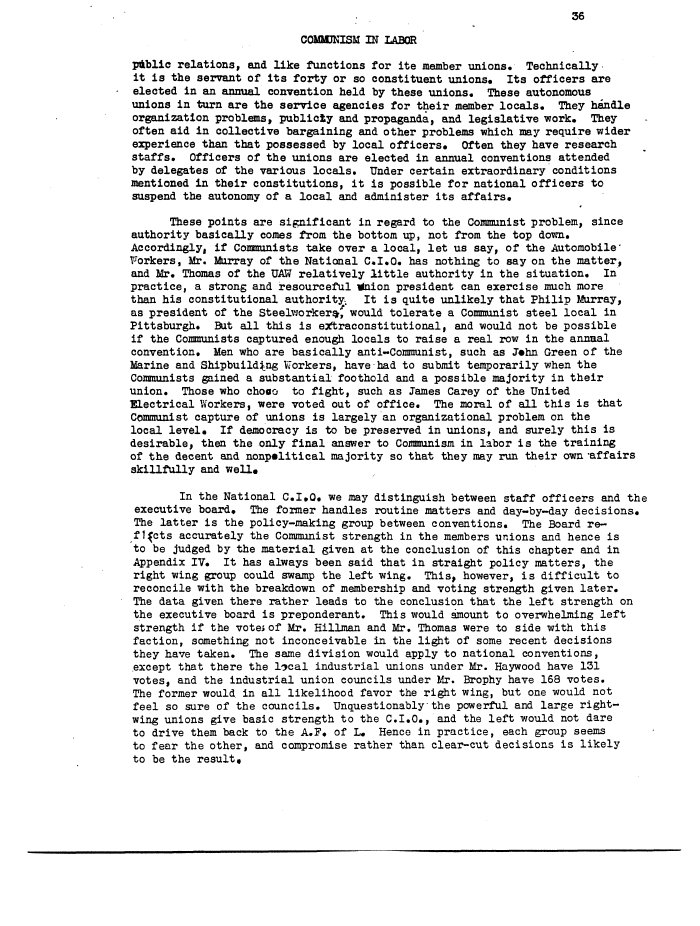 |
||||
 |
||||
| 36 C01MTKISM IN LABOR public relations, and like functions for ite member unions* Technically it is the servant of its forty or so constituent unions. Its officers are elected in an nnmial convention held by these unions. These autonomous unions in turn are the service agencies for their member locals. They handle organization problems, publicty and propaganda, and legislative work. They often aid in collective bargaining and other problems which may require wider experience than that possessed by local officers. Often they have research staffs. Officers of the unions are elected in annual conventions attended by delegates of the various locals. Under certain extraordinary conditions mentioned in their constitutions, it is possible for national officers to suspend the autonomy of a local and administer its affairs. These points are significant in regard to the Communist problem, since authority basically comes from the bottom up, not from the top down. Accordingly, if Communists take over a local, let us say, of the Automobile* Workers, Mr. Murray of the National C.I.O. has nothing to say on the matter, and Mr. Thomas of the UAW relatively little authority in the situation. In practice, a strong and resourceful irfnion president can exercise much more than his constitutional authority; It is quite unlikely that Philip Murray, as president of the Steelworkers*' would tolerate a Communist steel local in Pittsburgh. But all this is extraconstitutional, and would not be possible if the Communists captured enough locals to raise a real row in the annaal convention. Men who are basically anti-Communist, such as J«hn Green of the Marine and Shipbuilding Workers, have had to submit temporarily when the Communists gained a substantial foothold and a possible majority in their union. Those who chooo to fight, such as James Carey of the United Electrical Workers, were voted out of office. The moral of all this is that Communist capture of unions is largely an organizational problem on the local level. If democracy is to be preserved in unions, and surely this is desirable, then the only final answer to Communism in labor is the training of the decent and nonp«litical majority so that they may run their own -affairs skillfully and well. In the National C.I.O. we may distinguish between staff officers and the executive board. The former handles routine matters and day-by-day decisions. The latter is the policy-making group between conventions. The Board re- fl^cts accurately the Communist strength in the members unions and hence is to be judged by the material given at the conclusion of this chapter and in Appendix IV. It has always been said that in straight policy matters, the right wing group could swamp the left wing. This, however, is difficult to reconcile with the breakdown of membership and voting strength given later. The data given there rather leads to the conclusion that the left strength on the executive board is preponderant. This would amount to overwhelming left strength if the votes of Mr. Hillman and Mr. Thomas were to side with this faction, something not inconceivable in the light of some recent decisions they have taken. The same division would apply to national conventions, .except that there the l?cal industrial unions under Mr. Haywood have 131 votes, and the industrial union councils under Mr. Brophy have 168 votes. The former would in all likelihood favor the right wing, but one would not feel so sure of the councils. Unquestionably the powerful and large right- wing unions give basic strength to the C.I.O., and the left would not dare to drive them back to the A.F. of L. Hence in practice, each group seems to fear the other, and compromise rather than clear-cut decisions is likely to be the result. |